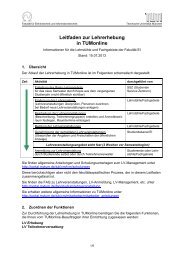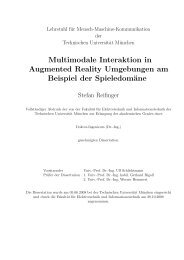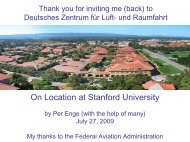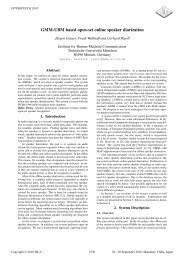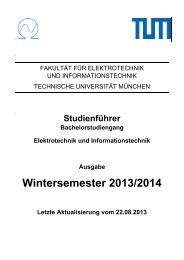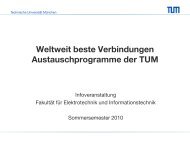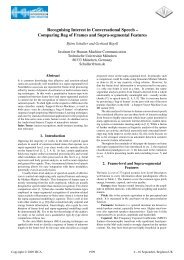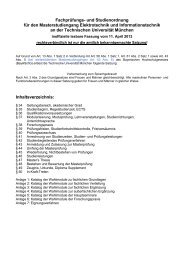A Network Interface Card Architecture for I/O Virtualization in ... - TUM
A Network Interface Card Architecture for I/O Virtualization in ... - TUM
A Network Interface Card Architecture for I/O Virtualization in ... - TUM
You also want an ePaper? Increase the reach of your titles
YUMPU automatically turns print PDFs into web optimized ePapers that Google loves.
A <strong>Network</strong> <strong>Interface</strong> <strong>Card</strong> <strong>Architecture</strong> <strong>for</strong> I/O <strong>Virtualization</strong><br />
<strong>in</strong> Embedded Systems<br />
Holm Rauchfuss<br />
Technische Universität<br />
München<br />
Institute <strong>for</strong> Integrated<br />
Systems<br />
D-80290 Munich, Germany<br />
holm.rauchfuss@tum.de<br />
Thomas Wild<br />
Technische Universität<br />
München<br />
Institute <strong>for</strong> Integrated<br />
Systems<br />
D-80290 Munich, Germany<br />
thomas.wild@tum.de<br />
Andreas Herkersdorf<br />
Technische Universität<br />
München<br />
Institute <strong>for</strong> Integrated<br />
Systems<br />
D-80290 Munich, Germany<br />
herkersdorf@tum.de<br />
ABSTRACT<br />
In this paper we present an architectural concept <strong>for</strong> network<br />
<strong>in</strong>terface cards (NIC) target<strong>in</strong>g embedded systems and support<strong>in</strong>g<br />
I/O virtualization. Current solutions <strong>for</strong> high per<strong>for</strong>mance<br />
comput<strong>in</strong>g do not sufficiently address embedded<br />
system requirements i.e., guarantee real-time constra<strong>in</strong>ts and<br />
differentiated service levels as well as only utilize limited<br />
HW resources. The central ideas of our work-<strong>in</strong>-progress<br />
concept are: A scalable and streaml<strong>in</strong>ed NIC architecture<br />
stor<strong>in</strong>g the rule sets (contexts) <strong>for</strong> virtual network <strong>in</strong>terfaces<br />
and associated <strong>in</strong><strong>for</strong>mation like DMA descriptors and<br />
producer/consumer lists primarily <strong>in</strong> the system memory.<br />
Only <strong>for</strong> currently active <strong>in</strong>terfaces or <strong>in</strong>terfaces with special<br />
requirements, e.g. hard real-time, the required <strong>in</strong><strong>for</strong>mation<br />
is cached on the NIC. By switch<strong>in</strong>g between the contexts<br />
the NIC can flexibly adapt to service a scalable number<br />
of <strong>in</strong>terfaces. With the contexts the proposed architecture<br />
also supports differentiated service levels. On the NIC<br />
(re-)configurable f<strong>in</strong>ite state mach<strong>in</strong>es (FSM) are handl<strong>in</strong>g<br />
the data path <strong>for</strong> I/O virtualization. This allows a more<br />
resource-limited NIC implementation. With a prelim<strong>in</strong>ary<br />
analysis we estimate the benefits of the proposed architecture<br />
and key components of the architecture are outl<strong>in</strong>ed.<br />
Categories and Subject Descriptors<br />
C.4 [Per<strong>for</strong>mance of Systems]: Design Studies, Per<strong>for</strong>mance<br />
Attributes; B.4.2 [Input/Output and Data Communications]:<br />
Input/Output Devices—Channels and Controllers<br />
General Terms<br />
Design, Per<strong>for</strong>mance<br />
Keywords<br />
I/O <strong>Virtualization</strong>, Embedded Systems, <strong>Network</strong> <strong>Interface</strong><br />
<strong>Card</strong><br />
1. INTRODUCTION<br />
Over the last decade(s), virtualization has become a ma<strong>in</strong>stream<br />
technique <strong>in</strong> data centers <strong>for</strong> better resource utilization<br />
by server consolidation. By abstraction, the physical<br />
ressources are shared between several virtual mach<strong>in</strong>es<br />
This paper appeared at the Second Workshop on I/O <strong>Virtualization</strong> (WIOV<br />
’10), March 13, 2010, Pittsburgh, PA, USA.<br />
(VM), so called doma<strong>in</strong>s. The improvement of underly<strong>in</strong>g<br />
virtual mach<strong>in</strong>e monitors (VMM) ([1], [2]) and HW ([4])<br />
<strong>for</strong> data centers have been targeted by research extensively.<br />
However virtualization is still an emerg<strong>in</strong>g topic <strong>for</strong> embedded<br />
systems, <strong>in</strong> particular multiprocessor system-on-chips.<br />
Their <strong>in</strong>creas<strong>in</strong>g per<strong>for</strong>mance and the comb<strong>in</strong>ation of applications<br />
with different requirements on a s<strong>in</strong>gle shared plat<strong>for</strong>m<br />
make them particularly well-suited <strong>for</strong> virtualization.<br />
First steps have been taken to analyze and adopt virtualization<br />
here ([6], [7]).<br />
A critical aspect is the virtualization of I/O, s<strong>in</strong>ce there the<br />
computational overhead and the per<strong>for</strong>mance degradation is<br />
high, <strong>in</strong> both data centers and embedded systems. Research<br />
<strong>for</strong> High Per<strong>for</strong>mance Comput<strong>in</strong>g (HPC) shows that near<br />
native throughput i.e., throughput equal to a set-up without<br />
virtualization, can be achieved by improvements <strong>in</strong> SW<br />
packet handl<strong>in</strong>g and offload<strong>in</strong>g virtualization onto the NIC<br />
([9], [10]). S<strong>in</strong>ce their focus is on overall system throughput<br />
maximization, but not on resource-limited architectures<br />
of NICs, the proposed architectures are not optimal <strong>for</strong> the<br />
usage <strong>in</strong> embedded systems and their specific requirements.<br />
The paper is structured as follows: Section 2 provides an<br />
overview on state of the art of I/O virtualization. Section<br />
3 describes the specific requirements <strong>for</strong> embedded systems<br />
and the fundamental concepts of the proposed NIC architecture.<br />
A prelim<strong>in</strong>ary per<strong>for</strong>mance estimation is given <strong>in</strong><br />
section 4. An exploration of key components is described <strong>in</strong><br />
section 5. Section 6 outl<strong>in</strong>es future work and summarizes<br />
the paper.<br />
2. STATE OF THE ART<br />
Shar<strong>in</strong>g physical network access between doma<strong>in</strong>s can be implemented<br />
<strong>in</strong> HW, SW or <strong>in</strong> a mixed mode [12]. The generic<br />
solution i.e., VMM only, dedicates one virtualization doma<strong>in</strong><br />
as driver doma<strong>in</strong> and exclusively assigns the network card to<br />
it. In such a system, other doma<strong>in</strong>s ga<strong>in</strong> network access by<br />
transferr<strong>in</strong>g packets via a SW-based bridge and front- and<br />
back-end device drivers [1]. Several protocol improvements<br />
reduce the overhead of the actual transmission of the packets<br />
between the doma<strong>in</strong>s, a comprehensive overview is given<br />
by [11]. I/O virtualization can also be per<strong>for</strong>med with<strong>in</strong> the<br />
VMM itself i.e., the hypervisor provides drivers <strong>for</strong> network<br />
cards and switches packets between the doma<strong>in</strong>s ([3]).
NIC<br />
Rx MAC Tx<br />
DMA<br />
NIC-CPU<br />
Management<br />
DMA-Mgmt.<br />
Signal<strong>in</strong>g<br />
Header-Pars<strong>in</strong>g<br />
Queue<strong>in</strong>g<br />
Schedul<strong>in</strong>g<br />
NIC Internal / Instruction Memory<br />
DMA<br />
System Bus<br />
CPU CPU<br />
System Memory<br />
P/C Lists<br />
Rx/Tx R<strong>in</strong>gs<br />
Packets<br />
communication path. This results <strong>in</strong> an <strong>in</strong>creased latency<br />
and (complex) schedul<strong>in</strong>g dependencies. Process<strong>in</strong>g time of<br />
the host cpu and system memory are utilized by this driver<br />
doma<strong>in</strong>. If the hypervisor is directly per<strong>for</strong>m<strong>in</strong>g I/O virtualization,<br />
the trusted comput<strong>in</strong>g base of the hypervisor is<br />
broadened with side-effects on security, footpr<strong>in</strong>t and verification.<br />
Multiple-queue network cards are limited <strong>in</strong> their number<br />
of available queue pairs. For support<strong>in</strong>g a scalable number<br />
of doma<strong>in</strong>s, such a NIC has either to keep unused pairs <strong>in</strong><br />
reserve or fallback to SW-based bridg<strong>in</strong>g <strong>for</strong> excess doma<strong>in</strong>s.<br />
Rx queues are served <strong>in</strong> the order given by packet arrival,<br />
result<strong>in</strong>g <strong>in</strong> possible head-of-l<strong>in</strong>e block<strong>in</strong>g <strong>for</strong> high-priority<br />
packets.<br />
Figure 1: RiceNIC with central process<strong>in</strong>g on PowerPC<br />
CPU<br />
A further improvement to the upper scenario is the usage<br />
of multi-queue network cards [9] such as Intel’s VMDq [13].<br />
Those network cards offer multiple pairs of Tx/Rx queues.<br />
This allows HW offload<strong>in</strong>g of packet (de-)multiplex<strong>in</strong>g and<br />
queu<strong>in</strong>g <strong>for</strong> doma<strong>in</strong>s based on their MAC address (and VLAN<br />
tag). A Tx/Rx pair is assigned to a VM and the driver doma<strong>in</strong><br />
is granted access to the memory region with the respective<br />
Tx/Rx buffers. Tx queues are served round-rob<strong>in</strong>.<br />
Doma<strong>in</strong>s can also directly access a NIC via virtual network<br />
<strong>in</strong>terfaces. Apparently, such approaches require extensions<br />
of the NIC i.e., dedicated queues, buffers, <strong>in</strong>terfaces and<br />
additional management logic. Be<strong>for</strong>e a doma<strong>in</strong> can use its<br />
virtual network <strong>in</strong>terface the VMM has to configure the NIC<br />
accord<strong>in</strong>gly.<br />
This concept is presented based on an IXP2400 network processor<br />
as a self-virtualiz<strong>in</strong>g network card [8]. Here, one microeng<strong>in</strong>e<br />
is used <strong>for</strong> demultiplex<strong>in</strong>g Rx traffic and another<br />
one <strong>for</strong> multiplex<strong>in</strong>g Tx traffic. Management of the network<br />
card is per<strong>for</strong>med <strong>in</strong> SW on the NIC XScale CPU.<br />
The set-up is restricted to 8 doma<strong>in</strong>s, s<strong>in</strong>ce the microeng<strong>in</strong>e<br />
is limited to 8 threads. To avoid coord<strong>in</strong>ation by the SW on<br />
the XScale, none of the other free microeng<strong>in</strong>es can be used<br />
<strong>for</strong> process<strong>in</strong>g Rx or Tx traffic <strong>in</strong> parallel.<br />
Direct I/O is also addressed by RiceNIC [10]. Here concurrent<br />
network access is provided by a network card based on<br />
an FPGA. It conta<strong>in</strong>s a PowerPC CPU and several dedicated<br />
HW components (see Fig. 1 <strong>for</strong> an abstract representation).<br />
The SW on the PowerPC per<strong>for</strong>ms data and control<br />
path functions <strong>for</strong> packet process<strong>in</strong>g. Each virtual network<br />
<strong>in</strong>terface requires 388 KB of NIC memory: 4 KB <strong>for</strong> context<br />
and 128 KB each <strong>for</strong> metadata, Tx buffer and Rx buffer.<br />
Although the a<strong>for</strong>ementioned solutions provide near native<br />
throughput, they have several shortcom<strong>in</strong>gs <strong>in</strong> respect to<br />
their applicability <strong>in</strong> embedded environments.<br />
Similarly, the concept <strong>for</strong> direct I/O is also restricted by the<br />
number of <strong>in</strong> HW supported virtual network <strong>in</strong>terfaces.<br />
The utilized IXP2400 network processor is targeted as l<strong>in</strong>e<br />
card <strong>for</strong> packet <strong>for</strong>ward<strong>in</strong>g and process<strong>in</strong>g i.e., it does not<br />
represent an optimal reference architecture <strong>for</strong> network cards<br />
support<strong>in</strong>g virtualization due to its limited <strong>in</strong>terface to the<br />
host.<br />
The primary goal of RiceNIC is to have a configurable and<br />
flexible NIC architecture. There<strong>for</strong>e most functionality is<br />
per<strong>for</strong>med by the firmware on the PowerPC. As negative<br />
side effect of this, the firmware is <strong>in</strong> the critical path <strong>for</strong> all<br />
packet process<strong>in</strong>g e.g., header pars<strong>in</strong>g, DMA descriptor generation<br />
and packet (de-)multiplex<strong>in</strong>g. Furthermore, extend<strong>in</strong>g<br />
RiceNIC with extra virtual network <strong>in</strong>terfaces requires<br />
additional NIC memory <strong>for</strong> each of them.<br />
F<strong>in</strong>ally, as the overall throughput per<strong>for</strong>mance is focus of<br />
the I/O virtualization research, m<strong>in</strong>or ef<strong>for</strong>ts have been put<br />
<strong>in</strong>to resource-limited concepts <strong>for</strong> network cards themselves.<br />
This motivates our proposed concept, that is presented subsequently.<br />
3. CONCEPT FOR AN ES-VNIC ARCHITEC-<br />
TURE<br />
To better understand the need <strong>for</strong> efficient I/O virtualization<br />
<strong>in</strong> embedded systems, we give an <strong>in</strong>troductory example<br />
here: An automotive head unit <strong>for</strong> premium cars represents<br />
a flexible and high-per<strong>for</strong>mance, but still embedded<br />
system. It consolidates <strong>in</strong>fota<strong>in</strong>ment (video, audio, Internet<br />
access, etc.) and numerous car-related, safety-critical<br />
functions (park distance control, user <strong>in</strong>terface <strong>for</strong> driver<br />
assistance systems, warn<strong>in</strong>g signals, etc.) on one HW plat<strong>for</strong>m<br />
and is connected via network to other electronic control<br />
units. Based on the actual driv<strong>in</strong>g situation, different sets of<br />
functions – which can be partitioned <strong>in</strong> doma<strong>in</strong>s to achieve<br />
robustness via isolation – and their communication are active.<br />
Those situations can change quickly e.g., jump<strong>in</strong>g from<br />
normal radio listen<strong>in</strong>g to display<strong>in</strong>g an urgent traffic warn<strong>in</strong>g.<br />
Most functions have to be runn<strong>in</strong>g concurrently to prevent<br />
disruptive delays by start<strong>in</strong>g them first. To be usable<br />
<strong>in</strong> an automotive environment, the head unit has also to be<br />
implemented <strong>in</strong> a very cost- and power-efficient way.<br />
In case of SW-based bridg<strong>in</strong>g and multi-queue network cards<br />
rely on a driver doma<strong>in</strong> which is <strong>in</strong>terleaved <strong>in</strong> the network
3.1 Requirement Analysis<br />
To fit both embedded systems and I/O virtualization NIC<br />
architecture concepts need to address special requirements:<br />
• The goal of overall maximum throughput has to be<br />
complemented with low latency and real-time process<strong>in</strong>g<br />
of packets <strong>for</strong> specific doma<strong>in</strong>s. For an embedded<br />
system a mix of hard real-time, soft real-time and<br />
best-ef<strong>for</strong>t doma<strong>in</strong>s has to be supported. As example,<br />
a hard real-time doma<strong>in</strong> with a networked closed-loop<br />
control requires to transmit traffic without jitter as<br />
<strong>in</strong> opposite to a best-ef<strong>for</strong>t doma<strong>in</strong> with bursty video<br />
streams. Overall, the network card should provide calculable<br />
and predictable response time <strong>for</strong> traffic transfers.<br />
With this requirement the usage of SW should<br />
not be considered <strong>in</strong> the critical transmission path –<br />
either on the NIC itself or via driver doma<strong>in</strong>.<br />
• Different service levels require enriched methods to<br />
process packets and to signal specific events to the<br />
VMM and doma<strong>in</strong>s. This <strong>in</strong>cludes prioritization of<br />
packets and <strong>in</strong>terfaces, and also observation of bandwidth<br />
guarantees and packet dropp<strong>in</strong>g probabilities.<br />
• The general design of the network card has to <strong>in</strong>clude<br />
only a limited number of HW components <strong>for</strong> enabl<strong>in</strong>g<br />
virtualization. In relation to the power consumption<br />
and per<strong>for</strong>mance of the complete embedded system the<br />
NIC should only contribute a small fraction to it, but<br />
still provide high throughput i.e., several 100 Mb/s or<br />
higher. Furthermore, the usage of NIC memory should<br />
be limited to a m<strong>in</strong>imum. Instead the system memory<br />
should be used as much as possible.<br />
• Per<strong>for</strong>m<strong>in</strong>g I/O virtualization by the VMM or doma<strong>in</strong>s<br />
should be avoided to keep the cores free <strong>for</strong> actual process<strong>in</strong>g<br />
as <strong>in</strong> embedded system CPU power is usually<br />
more spare than <strong>in</strong> HPC systems.<br />
In general, I/O virtualization requires a NIC to per<strong>for</strong>m the<br />
follow<strong>in</strong>g tasks efficiently:<br />
• Header-Pars<strong>in</strong>g: The header of <strong>in</strong>com<strong>in</strong>g packets<br />
has to be parsed to determ<strong>in</strong>e the dest<strong>in</strong>ation doma<strong>in</strong>.<br />
The MAC dest<strong>in</strong>ation address and VLAN tag of the<br />
Ethernet header are only required <strong>for</strong> layer 2 switch<strong>in</strong>g.<br />
• Buffer<strong>in</strong>g: It must be possible to efficiently buffer a<br />
packet, because prior packets blocks further process<strong>in</strong>g<br />
or packets with higher priority have to be processed<br />
first.<br />
• Schedul<strong>in</strong>g: The NIC should be able to switch process<strong>in</strong>g<br />
between packets either due to temporarily block<strong>in</strong>gs<br />
or to handle packets of doma<strong>in</strong>s with higher priority<br />
first. There<strong>for</strong>e, the NIC can multiplex outgo<strong>in</strong>g<br />
packets from the doma<strong>in</strong>s and demultiplex <strong>in</strong>com<strong>in</strong>g<br />
traffic more sophisticated than by simple round-rob<strong>in</strong>.<br />
• DMA: The NIC should have the ability to transfer a<br />
packet to or from the (system) memory on its own.<br />
NIC<br />
Rx MAC Tx<br />
Local Cache <strong>for</strong> Contexts,<br />
P/C Lists, Rx/Tx Queues<br />
Header-Pars<strong>in</strong>g<br />
FSMs<br />
Management<br />
Schedul<strong>in</strong>g<br />
Queue-Alloc<br />
NIC Buffer<br />
Signal<strong>in</strong>g<br />
DMA<br />
System Bus<br />
System Memory<br />
CPU<br />
CPU<br />
Contexts<br />
P/C Lists<br />
Rx/Tx R<strong>in</strong>gs<br />
Packets<br />
Figure 2: Concept of ES-VNIC architecture<br />
• Signal<strong>in</strong>g: Based on pre-def<strong>in</strong>ed service levels the<br />
NIC should be able to <strong>in</strong>dividually signal certa<strong>in</strong> events<br />
to the VMM or directly to doma<strong>in</strong>s. Events can be <strong>in</strong>terrupts<br />
<strong>for</strong> new packet arrival or request<strong>in</strong>g new DMA<br />
descriptors.<br />
• Management: The basic management <strong>for</strong> packet process<strong>in</strong>g<br />
i.e., (re-)configuration of HW blocks or coord<strong>in</strong>ation<br />
of the <strong>in</strong>dividual tasks should be per<strong>for</strong>med<br />
with<strong>in</strong> the NIC.<br />
3.2 Proposed <strong>Architecture</strong> and Exemplary Packet<br />
Process<strong>in</strong>g<br />
The above requirements and considerations are driv<strong>in</strong>g our<br />
proposal <strong>for</strong> a new Embedded System specific VNIC (ES-<br />
VNIC) architecture (see Fig. 2). It should provide the right<br />
trade-off between high throughput and QoS comb<strong>in</strong>ed with<br />
real-time versus ultimate throughput (<strong>in</strong> server or HPC environments<br />
with 10s of Gb/s). It relies on a tailored set<br />
of f<strong>in</strong>ite state mach<strong>in</strong>es specifically crafted <strong>for</strong> handl<strong>in</strong>g the<br />
tasks described above. By this, the footpr<strong>in</strong>t of I/O virtualization<br />
<strong>in</strong> the HW is reduced and better support <strong>for</strong><br />
real-time constra<strong>in</strong>ts and service levels of doma<strong>in</strong>s can be<br />
provided. By decoupl<strong>in</strong>g those FSMs, parallel and pipel<strong>in</strong>ed<br />
process<strong>in</strong>g is possible.<br />
To improve scalability, the resources (queues, caches, buffer)<br />
on the NIC are not be constantly occupied by doma<strong>in</strong>s or<br />
<strong>in</strong>terfaces, but <strong>in</strong>stead assigned (dynamically). Different levels<br />
of service may be provided. For <strong>in</strong>terfaces with real-time<br />
constra<strong>in</strong>ts, configuration and queues always reside with<strong>in</strong><br />
the ES-VNIC. Best-ef<strong>for</strong>t <strong>in</strong>terfaces <strong>in</strong> opposite share available<br />
resources i.e., their rule sets are loaded on-demand from<br />
system memory replac<strong>in</strong>g the <strong>in</strong><strong>for</strong>mation of <strong>in</strong>active <strong>in</strong>terfaces.<br />
The NIC conta<strong>in</strong>s a standard MAC which is wrapped by<br />
flexible HW extensions to enable direct I/O. Those extensions<br />
are described best by expla<strong>in</strong><strong>in</strong>g their <strong>in</strong>teraction <strong>for</strong><br />
process<strong>in</strong>g an <strong>in</strong>com<strong>in</strong>g Ethernet packet (see Fig. 3). This<br />
figure is a message sequence chart representation of the <strong>in</strong>com<strong>in</strong>g<br />
packet process<strong>in</strong>g: The communication between the
MAC NIC Buffer Header-Pars<strong>in</strong>g Schedul<strong>in</strong>g Queue-Alloc Management DMA System Memory<br />
Figure 3: Process<strong>in</strong>g packet with ES-VNIC (Rx path)<br />
different extensions is visualized by directed l<strong>in</strong>es i.e., hand<strong>in</strong>g<br />
over data or trigger<strong>in</strong>g those extensions. A block stands<br />
<strong>for</strong> a delay <strong>in</strong> this extension either <strong>for</strong> process<strong>in</strong>g or stor<strong>in</strong>g<br />
data. Time is progress<strong>in</strong>g down the Y axis i.e., the figure<br />
has to be read from top to down.<br />
A packet that arrives at the MAC is temporarily stored <strong>in</strong><br />
the NIC buffer and the header is sent <strong>in</strong> parallel to the<br />
header-pars<strong>in</strong>g unit where the relevant <strong>in</strong><strong>for</strong>mation regard<strong>in</strong>g<br />
to which doma<strong>in</strong> this packet should be routed is extracted.<br />
These actions are per<strong>for</strong>med at l<strong>in</strong>e speed. As only<br />
the header is parsed the header-pars<strong>in</strong>g unit completes be<strong>for</strong>e<br />
the complete packet is stored at the buffer.<br />
The NIC buffer allows to store a maximum-sized Ethernet<br />
packet on the whole. It is possible to access any packet<br />
arbitrarily. There<strong>for</strong>e, packets do not have to be processed<br />
<strong>in</strong> their <strong>in</strong>com<strong>in</strong>g order e.g., high-priority packets <strong>for</strong> realtime<br />
tasks can be preferred. The address of the packet is<br />
handed to the header-pars<strong>in</strong>g unit which comb<strong>in</strong>es it with<br />
the extracted header <strong>in</strong><strong>for</strong>mation <strong>for</strong> identify<strong>in</strong>g the packet.<br />
With the extracted header <strong>in</strong><strong>for</strong>mation the management FSM<br />
can then start to select the context <strong>for</strong> process<strong>in</strong>g this packet.<br />
In this context all relevant <strong>in</strong><strong>for</strong>mation regard<strong>in</strong>g the handl<strong>in</strong>g<br />
is stored, <strong>for</strong> example which priority such a packet<br />
should have, which are the conditions <strong>for</strong> signal<strong>in</strong>g the doma<strong>in</strong><br />
of the arrival of the packet, etc. The ma<strong>in</strong> store <strong>for</strong><br />
those contexts is on the system memory <strong>in</strong> order to limit the<br />
resources <strong>in</strong> the ES-VNIC. Only a small cache <strong>for</strong> contexts<br />
with packets under process<strong>in</strong>g is present on the ES-VNIC.<br />
Contexts <strong>for</strong> critical doma<strong>in</strong>s can be p<strong>in</strong>ned to the cache<br />
permanently. Contexts <strong>for</strong> best-ef<strong>for</strong>t or low-priority packets<br />
<strong>in</strong>stead have to be loaded from system memory, <strong>in</strong>volv<strong>in</strong>g<br />
writ<strong>in</strong>g back contexts which need to be replaced due to the<br />
cache size limitation. A context can conta<strong>in</strong> the rule set<br />
<strong>for</strong> a complete doma<strong>in</strong>, but also <strong>for</strong> <strong>in</strong>dividual Rx or Tx<br />
network <strong>in</strong>terfaces. A context can have several kilobytes of<br />
data due to conta<strong>in</strong><strong>in</strong>g advanced rules, priority sett<strong>in</strong>gs and<br />
configurations.<br />
As load<strong>in</strong>g and writ<strong>in</strong>g back may take a reasonable amount<br />
of time, the management FSM is designed to handle several<br />
such processes and contexts <strong>in</strong> parallel, switch<strong>in</strong>g between<br />
them to decrease stall<strong>in</strong>g. At any time several packets shall<br />
be processed by the ES-VNIC <strong>in</strong> parallel.<br />
Similar to the context, the DMA descriptors and the respective<br />
producer/consumer lists (P/C lists) have to be available<br />
at the local cache or to be fetched from the system memory if<br />
required. The DMA descriptors are stored <strong>in</strong> generic queues<br />
where they can be read by the scheduler. The queue-alloc<br />
unit is responsible to assign and fill those queues.<br />
Based on the contexts of the current packets, the schedul<strong>in</strong>g<br />
unit decides which packet should be processed next and<br />
fetches a DMA descriptor from the respective queue. Along<br />
the respective address of packet <strong>in</strong> the NIC buffer, this <strong>in</strong><strong>for</strong>mation<br />
is handed over to the DMA unit. The DMA unit<br />
will then write the packet over the system bus to the system<br />
memory. Afterwards, it <strong>in</strong><strong>for</strong>ms the management unit<br />
about the completion of the action. The respective producer/consumer<br />
list is updated and written back to the system<br />
memory where it can be read by the doma<strong>in</strong>. Then<br />
the management unit configures the signal<strong>in</strong>g unit accord<strong>in</strong>gly<br />
to the context i.e., immediate <strong>in</strong>terrupt <strong>for</strong> the packet<br />
or wait <strong>for</strong> reach<strong>in</strong>g a threshold of packets. The respective<br />
signal<strong>in</strong>g concludes the packet process<strong>in</strong>g.<br />
The same units are utilized <strong>for</strong> send<strong>in</strong>g a packet. Only the<br />
header-pars<strong>in</strong>g unit is not used as a packet is already associated<br />
with a Tx <strong>in</strong>terface and there<strong>for</strong>e with the respective<br />
context. The ES-VNIC management is triggered from the<br />
driver to send a packet. The respective context is loaded<br />
and the DMA descriptor is read to an allocated queue. If<br />
the schedul<strong>in</strong>g unit decides to send this packet the descriptor<br />
is handed over to the DMA unit which writes the packet<br />
to the NIC buffer. After completely written it is sent out<br />
via the MAC.<br />
Doma<strong>in</strong>s can modify the data structures <strong>for</strong> context and<br />
DMA descriptors <strong>in</strong> the system memory only after be<strong>in</strong>g<br />
validated by the hypervisor to prevent erroneous or malicious<br />
<strong>in</strong>put. This is abstracted via calls to the hypervisor<br />
<strong>in</strong> the driver <strong>for</strong> the doma<strong>in</strong>. The hypervisor notifies the<br />
ES-VNIC which <strong>in</strong>validates cached <strong>in</strong><strong>for</strong>mation and fetches<br />
new <strong>in</strong>put from system memory.
MAC<br />
DMA<br />
NIC Internal / Instruction<br />
Memory<br />
NIC-CPU DMA System Memory<br />
can be per<strong>for</strong>med <strong>in</strong> less clock cycles with f<strong>in</strong>ite state<br />
mach<strong>in</strong>es.<br />
• Hav<strong>in</strong>g a pipel<strong>in</strong>ed architecture with different stages,<br />
that are FSMs, allows the same throughput with a<br />
lower frequency than per<strong>for</strong>m<strong>in</strong>g the respective tasks<br />
<strong>in</strong> sequential SW on a CPU.<br />
These po<strong>in</strong>ts lead to the work hypothesis that the ES-VNIC<br />
architecture needs low and determ<strong>in</strong>istic process<strong>in</strong>g time.<br />
Prerequisite is that the FSMs are flexible enough to service a<br />
mix of hard real-time, soft real-time and best-ef<strong>for</strong>t doma<strong>in</strong>s.<br />
In a <strong>for</strong>mal approach the process<strong>in</strong>g time by ES-VNIC can<br />
be <strong>for</strong>mulated as follows:<br />
T DelayRx = max(T NIC Buffer , T Header−P ars<strong>in</strong>g )<br />
Figure 4: Process<strong>in</strong>g packet with a CPU-centric<br />
NIC (Rx path)<br />
4. PRELIMINARY PERFORMANCE ESTI-<br />
MATION<br />
Based on the presented ES-VNIC architecture concept we<br />
assess a prelim<strong>in</strong>ary per<strong>for</strong>mance estimation. Focus is on<br />
the <strong>in</strong>com<strong>in</strong>g packet process<strong>in</strong>g sequence as <strong>in</strong>troduced and<br />
described <strong>for</strong> ES-VNIC <strong>in</strong> section 3.<br />
The process<strong>in</strong>g sequence <strong>for</strong> a network card per<strong>for</strong>m<strong>in</strong>g I/O<br />
virtualization via CPU firmware like RiceNIC is depicted<br />
<strong>in</strong> Fig. 4. Incom<strong>in</strong>g packets are transferred from the MAC<br />
via DMA to the NIC <strong>in</strong>ternal memory. Afterwards the NIC<br />
CPU is notified. The SW then processes the packet <strong>in</strong>clud<strong>in</strong>g<br />
header-pars<strong>in</strong>g, schedul<strong>in</strong>g and queu<strong>in</strong>g plus manag<strong>in</strong>g<br />
and configur<strong>in</strong>g the other HW blocks. Dur<strong>in</strong>g process<strong>in</strong>g the<br />
SW has to access the NIC <strong>in</strong>ternal memory <strong>for</strong> packet data<br />
and <strong>in</strong>struction code. The number of accesses depends on<br />
the size and association of the NIC CPU. After be<strong>in</strong>g queued<br />
the packet is transferred via DMA to the system memory.<br />
A simple qualitative comparison of the sequences reveals the<br />
follow<strong>in</strong>g po<strong>in</strong>ts:<br />
• The firmware on the s<strong>in</strong>gle CPU per<strong>for</strong>m<strong>in</strong>g the tasks<br />
<strong>for</strong> I/O virtualization constitute a sequential trail of<br />
tasks which due to the process<strong>in</strong>g latency may evolve<br />
to a bottleneck. Add<strong>in</strong>g further CPUs is not a favorable<br />
solution as it would contradict the goal of a<br />
resource-limited implementation.<br />
• On a CPU with data cache (re-)load<strong>in</strong>g and <strong>in</strong>struction<br />
fetch<strong>in</strong>g, it is not optimal to per<strong>for</strong>m tasks like header<br />
pars<strong>in</strong>g, queu<strong>in</strong>g or manag<strong>in</strong>g DMA descriptors due<br />
to the lack of temporal locality (<strong>for</strong> example header<br />
pars<strong>in</strong>g is per<strong>for</strong>med only once per packet). These task<br />
+ T Management<br />
+ max(T Schedul<strong>in</strong>g , T Queue−Alloc )<br />
+ T DMA (1)<br />
T NIC Buffer is the time needed to transfer the <strong>in</strong>com<strong>in</strong>g<br />
packet to the NIC Buffer, T Header−P ars<strong>in</strong>g to parse the respective<br />
header. Both actions are per<strong>for</strong>med <strong>in</strong> parallel and<br />
at l<strong>in</strong>e speed. Apparently, T NIC Buffer is dom<strong>in</strong>ant here<br />
and dependent on the packet size.<br />
T Management subsumes sett<strong>in</strong>g the configuration <strong>for</strong> the follow<strong>in</strong>g<br />
FSMs accord<strong>in</strong>g to the context of this packet. This<br />
<strong>in</strong>cludes the conditional fetch of this context from the system<br />
memory first. If the context is cached, it should only<br />
need a few clock cycles to per<strong>for</strong>m this operation. The time<br />
<strong>for</strong> fetch<strong>in</strong>g context is dom<strong>in</strong>ated by the per<strong>for</strong>mance of system<br />
bus and memory. Contexts <strong>for</strong> (hard) real-time <strong>in</strong>terfaces<br />
need to be p<strong>in</strong>ned to the cache. On the one hand<br />
this constra<strong>in</strong>t results <strong>in</strong> an easy calculable upper bound <strong>for</strong><br />
T Management, but on the other hand will reduce the slots <strong>for</strong><br />
contexts of best-ef<strong>for</strong>t or low-priority packets.<br />
The queue-alloc and scheduler unit are triggered both by<br />
the management unit and run concurrently. The queue-alloc<br />
unit needs T Queue−Alloc to allocate the needed DMA descriptor<br />
and the scheduler unit requires T Schedul<strong>in</strong>g to schedule<br />
the next packet to be transferred via DMA. As DMA descriptors<br />
need to be fetched from system memory <strong>in</strong> case<br />
that they are not already on the NIC, the queue-alloc unit<br />
needs more time to f<strong>in</strong>ish. For (hard) real-time packets the<br />
DMA queues should there<strong>for</strong>e already be pre-allocated and<br />
the descriptors pre-fetched to guarantee an upper bound.<br />
F<strong>in</strong>ally, T DMA is the time needed to transmit a packet from<br />
the NIC Buffer to the system memory and depends on packet<br />
size and on the per<strong>for</strong>mance of system bus and memory.<br />
The follow<strong>in</strong>g term describes the delta time of ES-VNIC i.e.,<br />
the time which can be spent <strong>in</strong> each stage of the pipel<strong>in</strong>ed<br />
architecture <strong>for</strong> process<strong>in</strong>g a packet:
System<br />
Memory<br />
Rx R<strong>in</strong>gs<br />
Tx R<strong>in</strong>gs<br />
A B [m] C D<br />
[n]<br />
System<br />
Memory<br />
Contexts<br />
A B …<br />
Z<br />
[m+n]<br />
NIC<br />
NIC<br />
From P/C Lists<br />
Assignable<br />
Queues<br />
A<br />
[o]<br />
To Schedul<strong>in</strong>g<br />
Local<br />
Cache<br />
A<br />
X<br />
X<br />
X<br />
[v]<br />
To P/C Lists<br />
A<br />
Multithreaded<br />
[w]<br />
FSMs<br />
To Queue-Alloc<br />
To Schedul<strong>in</strong>g<br />
Figure 5: Key component: Queue-Allocation<br />
From Header Pars<strong>in</strong>g<br />
Figure 6: Key component: Management (with Contexts)<br />
T DeltaRx = max( max(T NIC Buffer , T Header−P ars<strong>in</strong>g ),<br />
T Management,<br />
max(T Schedul<strong>in</strong>g , T Queue−Alloc ),<br />
T DMA) (2)<br />
If this time matches the rate of consecutive <strong>in</strong>com<strong>in</strong>g packets,<br />
ES-VNIC can cope with the the speed of this traffic so<br />
that no packet drops will occur. This is crucial to support<br />
network <strong>in</strong>terfaces <strong>for</strong> hard real-time and critical doma<strong>in</strong>s.<br />
This time is strongly dom<strong>in</strong>ated by the system bus and memory.<br />
The per<strong>for</strong>mance of the ES-VNIC is apparently driven by<br />
the system bus and memory i.e., systematically l<strong>in</strong>ked to<br />
the per<strong>for</strong>mance of the (embedded) system itself.<br />
As worst-case scenario <strong>for</strong> T DeltaRx the requirement to handle<br />
a constant flow of packets with m<strong>in</strong>imum frame size and<br />
m<strong>in</strong>imum <strong>in</strong>terval <strong>for</strong> a 1 Gbit/s MAC can be used. A packet<br />
size of 64 byte and 20 byte overhead <strong>for</strong> preamble, start-offrame-delimiter<br />
and <strong>in</strong>terframe gap results <strong>in</strong>:<br />
(64 + 20) ∗ 8bit<br />
1Gbit/s<br />
= 672 nanoseconds (3)<br />
This means that every 672 nanoseconds a new packet arrives<br />
and has to be processed. With a clock of 125 MHz <strong>for</strong> Gigabit<br />
Ethernet every pipel<strong>in</strong>e stage would have only 84 cycles<br />
to complete its task.<br />
5. EXPLORATION OF KEY ARCHITECTURE<br />
COMPONENTS<br />
We started to model the key components of the proposed<br />
ES-VNIC architecture <strong>for</strong> simulation <strong>in</strong> SystemC [14]. As<br />
described <strong>in</strong> section 3, the architecture should only utilize<br />
flexible HW resources. Focus is there<strong>for</strong>e on the related<br />
FSMs, structures and data elements <strong>in</strong> queue-allocation (see<br />
Fig. 5) and management (see Fig. 6). The focus should be<br />
on design, the exploration of the size of local buffers as well<br />
as the underly<strong>in</strong>g data paths of the components and efficient<br />
load<strong>in</strong>g of contexts.<br />
5.1 Queue-Allocation<br />
The Rx and Tx r<strong>in</strong>gs that conta<strong>in</strong> the DMA descriptors are<br />
stored <strong>in</strong> the system memory – <strong>in</strong> this example Rx <strong>in</strong>terfaces<br />
A, B and Tx <strong>in</strong>terfaces C, D. Their content is def<strong>in</strong>ed by the<br />
network drivers.<br />
On the NIC, a limited set of assignable queues is available.<br />
For <strong>in</strong>terfaces with real-time constra<strong>in</strong>ts such a queue is<br />
blocked and filled with the maximum number of available<br />
descriptors. Otherwise, if triggered by a context <strong>for</strong> either<br />
send<strong>in</strong>g or receiv<strong>in</strong>g a packet, a queue-allocation is done<br />
i.e., if no queue already conta<strong>in</strong>s the respective descriptor(s)<br />
<strong>for</strong> this context a queue is reserved and the descriptors are<br />
fetched from the system memory. This fetch<strong>in</strong>g is done by a<br />
dedicated HW eng<strong>in</strong>e. In Fig. 5 one queue is blocked <strong>for</strong> A<br />
(depicted by an <strong>in</strong>scribed A <strong>in</strong> this queue), the others have<br />
to share the second queue. This may result <strong>in</strong> flush<strong>in</strong>g of<br />
descriptors <strong>for</strong> an <strong>in</strong>active context or a context with lower<br />
priority. A further fetch is issued if a threshold <strong>for</strong> the P/C<br />
list is reached. That threshold is def<strong>in</strong>ed by the context.<br />
There can be more or less network <strong>in</strong>terfaces <strong>for</strong> receiv<strong>in</strong>g<br />
packets than <strong>for</strong> send<strong>in</strong>g, s<strong>in</strong>ce Rx and Tx r<strong>in</strong>gs do not have<br />
to be paired. With this feature it is possible to have a Tx<br />
<strong>in</strong>terface <strong>for</strong> broadcast<strong>in</strong>g status <strong>in</strong><strong>for</strong>mation and no correspondent<br />
Rx <strong>in</strong>terface (if no acknowledges are needed); this<br />
is a quite common scenario <strong>for</strong> embedded systems. Furthermore,<br />
to prevent head-of-l<strong>in</strong>e block<strong>in</strong>gs <strong>for</strong> one doma<strong>in</strong>, several<br />
Rx <strong>in</strong>terfaces <strong>for</strong> receiv<strong>in</strong>g packets with different service<br />
levels can be established.<br />
In general, the number of assignable queues (o) is limited<br />
and smaller than the number of Rx r<strong>in</strong>gs (m) and Tx r<strong>in</strong>gs<br />
(n) <strong>in</strong> the system memory i.e., m + n > o.<br />
5.2 Management (with Contexts)<br />
Contexts <strong>in</strong> system memory, cache <strong>for</strong> them on the NIC,<br />
multithreaded FSMs and connections to other units do assembly<br />
management. In our example the <strong>in</strong>terfaces A to Z<br />
exist and their contexts are kept <strong>in</strong> system memory (m <strong>for</strong><br />
Rx <strong>in</strong>terfaces plus n <strong>for</strong> Tx <strong>in</strong>terfaces).<br />
If send<strong>in</strong>g or receiv<strong>in</strong>g a packet and not hav<strong>in</strong>g the respec-
tive context <strong>in</strong> the ES-VNIC the context is fetched from the<br />
system memory and stored <strong>in</strong> a cache slot (v). The data of<br />
the context is loaded <strong>in</strong>to one of the multithreaded FSMs<br />
(w) by a dedicated HW eng<strong>in</strong>e. Us<strong>in</strong>g fixed entry po<strong>in</strong>ts the<br />
packet process<strong>in</strong>g management is then started.<br />
Load<strong>in</strong>g the context results <strong>in</strong> two th<strong>in</strong>gs:<br />
• First the FSM is (re-)configured i.e., the respective<br />
state diagram is modified. By default the state diagram<br />
is preset to the most common case <strong>for</strong> an <strong>in</strong>terface.<br />
The context can then add or remove states<br />
and transitions adapt<strong>in</strong>g the ES-VNIC <strong>for</strong> process<strong>in</strong>g<br />
packet <strong>for</strong> this specific <strong>in</strong>terface. For example, FSMs<br />
<strong>for</strong> <strong>in</strong>terfaces be<strong>in</strong>g polled can be stripped from states<br />
and transitions <strong>for</strong> signal<strong>in</strong>g <strong>in</strong>com<strong>in</strong>g messages. Another<br />
option are additional (security) steps <strong>for</strong> a critical<br />
packet and its <strong>in</strong>terface prevent<strong>in</strong>g deletion of the<br />
packet from the NIC buffer after be<strong>in</strong>g copied <strong>in</strong> the<br />
system memory and be<strong>in</strong>g validated there.<br />
• Second data from the context is used as <strong>in</strong>put <strong>for</strong> registers<br />
that def<strong>in</strong>e and trigger the other FSMs (queuealloc,<br />
schedul<strong>in</strong>g, P/C lists). For multithread<strong>in</strong>g there<br />
are multiple sets of the <strong>in</strong>put and output register <strong>for</strong> an<br />
FSM. By mapp<strong>in</strong>g a thread to a packet the ES-VNIC<br />
can switch fast between process<strong>in</strong>g of several packets<br />
(similar to process<strong>in</strong>g <strong>in</strong> a multithreaded CPU).<br />
Similar to queues <strong>in</strong> queue-alloc, contexts can be p<strong>in</strong>ned to<br />
cache slots and FSMs. In our example here this would be<br />
<strong>for</strong> A represent<strong>in</strong>g a hard real-time <strong>in</strong>terface. The other<br />
<strong>in</strong>terfaces have to share the other available resources.<br />
6. FUTURE WORK AND SUMMARY<br />
Future work comprises of: Simulation of the key components<br />
to validate the proposed architecture and the prelim<strong>in</strong>ary<br />
per<strong>for</strong>mance estimations. Here, set-ups which require<br />
displacement of contexts, DMA descriptors and P/C lists<br />
on the ES-VNIC dur<strong>in</strong>g run-time are of particular <strong>in</strong>terest.<br />
This will <strong>in</strong>volve dimension<strong>in</strong>g of cache size, packet buffers,<br />
queues and the number of multithreaded FSMs as well as<br />
functional verification of the those FSMs. Afterwards, the<br />
network card architecture should be physically implemented<br />
as part of an MPSoC demonstrator <strong>in</strong> an FPGA to prove<br />
the applicability to real world scenarios.<br />
In this work-<strong>in</strong>-progress paper we <strong>in</strong>troduced a new virtualiz<strong>in</strong>g<br />
NIC architecture concept particularly address<strong>in</strong>g the<br />
requirements of I/O virtualization <strong>in</strong> embedded systems.<br />
We showed that current concepts that address HPC do not<br />
match with those requirements. Thus, the needs <strong>for</strong> this application<br />
area have been discussed and a favorable design has<br />
been deduced. A prelim<strong>in</strong>ary per<strong>for</strong>mance estimation and a<br />
short presentation of key elements have also been given.<br />
7. REFERENCES<br />
[1] P. Barham, B. Dragovic, K. Fraser, S. Hand, T. Harris,<br />
A. Ho, R. Neugebauer, I. Pratt, and A. Warfield. Xen<br />
and the art of virtualization. In Proceed<strong>in</strong>gs of the<br />
n<strong>in</strong>eteenth ACM symposium on Operat<strong>in</strong>g Systems<br />
Pr<strong>in</strong>ciples (SOSP19), ACM Press, 2003.<br />
[2] A. Kivity, Y. Kamay, and D. Laor. kvm: the L<strong>in</strong>ux<br />
Virtual Mach<strong>in</strong>e Monitor. In L<strong>in</strong>ux Symposium, 2007.<br />
[3] M. Mahal<strong>in</strong>gam and R. Brunner. I/O <strong>Virtualization</strong><br />
(IOV) For Dummies. In VMWorld, 2007.<br />
[4] L. van Doorn. Hardware virtualization trends. In<br />
Proceed<strong>in</strong>gs of the 2nd <strong>in</strong>ternational conference on<br />
Virtual execution environments, 2006 (June).<br />
[5] A. Menon, A. L. Cox, and W. Zwaenepoel. Optimiz<strong>in</strong>g<br />
network virtualization <strong>in</strong> Xen. In Proceed<strong>in</strong>gs of the<br />
USENIX Annual Technical Conference, 2006 (June).<br />
[6] G. Heiser. The role of virtualization <strong>in</strong> embedded<br />
systems. In Proceed<strong>in</strong>gs of the 1st workshop on Isolation<br />
and <strong>in</strong>tegration <strong>in</strong> embedded systems, 2008 (April).<br />
[7] H. Inoue, A. Ikeno, M. Kondo, J. Sakai, and<br />
M. Edahiro. VIRTUS: A new processor virtualization<br />
architecture <strong>for</strong> security-oriented next-generation<br />
mobile term<strong>in</strong>als. In Proceed<strong>in</strong>gs of the 43rd annual<br />
conference on Design automation, 2006.<br />
[8] H. Raj and K. Schwan. Implement<strong>in</strong>g a scalable<br />
self-virtualiz<strong>in</strong>g network <strong>in</strong>terface on a multicore<br />
plat<strong>for</strong>m. In Workshop on the Interaction between<br />
Operat<strong>in</strong>g Systems and Computer <strong>Architecture</strong>, 2005<br />
(October).<br />
[9] K. K. Ram, J. R. Santos, Y. Turner, A. L. Cox, and<br />
S. Rixner. Achiev<strong>in</strong>g 10 Gb/s us<strong>in</strong>g safe and<br />
transparent network <strong>in</strong>terface virtualization. In<br />
Proceed<strong>in</strong>gs of the 2009 ACM SIGPLAN/SIGOPS<br />
<strong>in</strong>ternational Conference on Virtual Execution<br />
Environments.<br />
[10] P. Willmann, J. Shafer, D. Carr, A. Menon, S. Rixner,<br />
A. L. Cox, and W. Zwaenepoel. Concurrent direct<br />
network access <strong>for</strong> virtual mach<strong>in</strong>e monitors. In<br />
Proceed<strong>in</strong>gs of the International Symposium on<br />
High-Per<strong>for</strong>mance Computer <strong>Architecture</strong>, 2007<br />
(February).<br />
[11] J. Wang. Survey of State-of-the-art <strong>in</strong> Inter-VM<br />
Communication Mechanisms. In Research Proficiency<br />
Report, 2009 (September).<br />
[12] J. R. Santos, Y. Turner, and J. Mudigona. Tam<strong>in</strong>g<br />
Heterogeneous NIC Capabilities <strong>for</strong> I/O <strong>Virtualization</strong>.<br />
In Proceed<strong>in</strong>gs of Workshop on I/O <strong>Virtualization</strong>,<br />
2008.<br />
[13] S. Ch<strong>in</strong>ni, R. Hiremane. Virtual Mach<strong>in</strong>e Device<br />
Queues. In Whitepaper, Intel, 2007.<br />
[14] T. Grötker, S. Liao, G. Mart<strong>in</strong> and S. Swan. System<br />
Design with SystemC. In Kluwer Academic Publishers,<br />
2002.<br />
With this paper, it is our objective to raise awareness <strong>for</strong> the<br />
research of I/O virtualization <strong>in</strong> embedded system network<br />
cards and the new challenges here.



